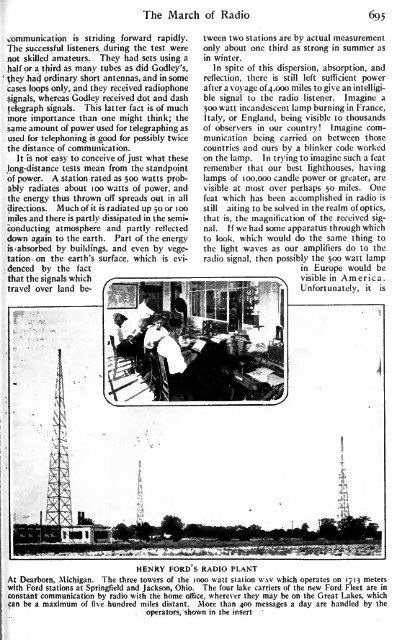Radio Broadcast - 1925, February - 113 Pages ... - VacuumTubeEra
Radio Broadcast - 1925, February - 113 Pages ... - VacuumTubeEra
Radio Broadcast - 1925, February - 113 Pages ... - VacuumTubeEra
You also want an ePaper? Increase the reach of your titles
YUMPU automatically turns print PDFs into web optimized ePapers that Google loves.
The March of <strong>Radio</strong> 695<br />
communication is striding forward rapidly.<br />
The successful listeners during the test were<br />
not skilled amateurs. They had sets using a<br />
half or a third as many tubes as did Godley's,<br />
they .had ordinary short antennas, and in some<br />
cases loops only, and they received radiophone<br />
signals, whereas Godley received dot and dash<br />
telegraph signals. This latter fact is of much<br />
more importance than one might think; the<br />
same amount of power used for telegraphing as<br />
used for telephoning is good for possibly twice<br />
the distance of communication.<br />
It is not easy to conceive of just what these<br />
long-distance tests mean from the standpoint<br />
of power. A station rated as 500 watts probably<br />
radiates about 100 watts of power, and<br />
the energy thus thrown off spreads out in all<br />
directions. Much of it is radiated up 50 or 100<br />
miles and there is<br />
partly dissipated in the semiconducting<br />
atmosphere and partly reflected<br />
down again to the earth. Part of the energy<br />
is absorbed by buildings, and even by vegetation<br />
on the earth's surface, which is evidenced<br />
by the fact<br />
that the signals which<br />
travel over land between<br />
two stations are by actual measurement<br />
only about one third as strong in summer as<br />
in winter.<br />
In spite of this dispersion, absorption, and<br />
reflection, there is still left sufficient power<br />
after a voyage of 4,000 miles to give an intelligible<br />
signal to the radio listener. Imagine a<br />
500 watt incandescent lamp burning in France,<br />
Italy, or England, being visible to thousands<br />
of observers in our country! Imagine communication<br />
being carried on between those<br />
countries and ours by a blinker code worked<br />
on the lamp. In trying to imagine such a feat<br />
remember that our best lighthouses, having<br />
lamps of 100,000 candle power or greater, are<br />
visible at most over perhaps 50 miles. One<br />
feat which has been accomplished in radio is<br />
still ailing to be solved in the realm of optics,<br />
that is, the magnification of the received signal.<br />
If we had some apparatus through which<br />
to look, which would do the same thing to<br />
the light waves as our amplifiers do to the<br />
radio signal, then possibly the 500 watt lamp<br />
in Europe would be<br />
visible in America.<br />
Unfortunately,<br />
it is<br />
HENRY FORD S RADIO PLANT<br />
At Dearborn, Michigan. The three towers of the 1000 watt station WAV which operates on 1713 meters<br />
with Ford stations at Springfield and Jackson, Ohio. The four lake carriers of the new Ford Fleet are in<br />
constant communication by radio with the home office, wherever they may be on the Great Lakes, which<br />
can be a maximum of five hundred miles distant. More than 400 messages a day are handled by the<br />
operators, shown in the insert
















